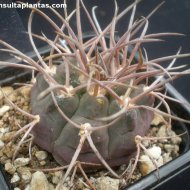Care of the cactus Gymnocalycium spegazzinii o Echinocactus loricatus |
|
The genus Gymnocalycium, family Cactaceae, includes more than 60 species of cacti native to South America. Some species are: Gymnocalycium spegazzinii, Gymnocalycium saglionis, Gymnocalycium damsii, Gymnocalycium baldianum, Gymnocalycium mostii, Gymnocalycium denudatum, Gymnocalycium schickendantzii, Gymnocalycium mihanovichii, Gymnocalycium schroederianum, Gymnocalycium vatteri, Gymnocalycium andreae, Gymnocalycium pflanzii, Gymnocalycium gibbosum, Gymnocalycium platense. Scientific synonym: Echinocactus loricatus. This species is native to the province of Salta, Argentina. They are spherical cacti (more cylindrical with age) and greenish grey, bluish gray or brownish gray in color that reach 20 cm (7.87") in height; They produce young when they are adults. They have 10-15 broad ribs with flat tubercles. The upper areoles have yellowish wool; they have 5-7 curved radial spines. The flowers appear at the apex of the plant, measure up to 5 cm (1.96") in diameter and are pinkish-white with a red center. They bloom in late spring. Due to its small dimensions, it's used in deep pots for patios and terraces, as indoor plants and in greenhouses. Gymnocalycium spegazzinii prefers a semi-shade exposure, avoiding direct sun during the central hours of the day. The winter safety temperature is 5 ºC (41 ºF). The soil can be a commercial substrate for cacti and succulent plants. The transplant is done in early spring. Echinocactus loricatus is very resistant to drought but appreciate regular watering in spring and summer, waiting for the substrate to dry completely. In autumn reduce watering a lot and do not water in winter. Gymnocalycium spegazzinii does not need fertilizer or pruning. Echinocactus loricatus is a plant quite resistant to the usual pests and diseases but very sensitive to the accumulation of water in the roots. If it's grown indoors it is important that there is good ventilation. Gymnocalycium spegazzinii is propagated from seeds sown in spring and by separation of suckers. |
Images of the cactus Gymnocalycium spegazzinii o Echinocactus loricatus |
Find plants
Gymnocalycium spegazzinii o Echinocactus loricatus | Care and Growing
© 2026 FavThemes





